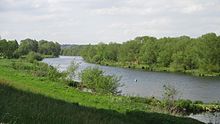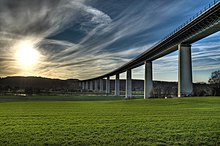Mintard
|
Mintard
City of Mülheim an der Ruhr
Coordinates: 51 ° 22 ′ 20 ″ N , 6 ° 54 ′ 16 ″ E
|
|
|---|---|
| Height : | 43 m |
| Residents : | 703 (December 31, 2013) |
| Postcodes : | 45479, 45481 |
| Primaries : | 0208, 02054 |
|
The Mintarder Dorfstraße in winter 2010
|
|
Mintard is a district of Mülheim an der Ruhr and is located in the southwest of the urban area directly on the Ruhr . It borders on Mülheim-Saarn , Mülheim-Menden (with Ickten) , Mülheim-Selbeck , Ratingen-Breitscheid and Essen-Kettwig . The population as of December 31, 2013 was 703 people.
history
Mintard was an old fron of the Gerresheim women's monastery , probably since the 11th century. The anachronistic notion that a village in the high medieval sense of a community and the parish church of St. Laurentius already existed here in 873 cannot be justified with a mention of Mintard in a document supposedly from 874, the Regenbirgischen document , because this document has long been considered a forgery has been exposed. The oldest evidence for the place name Mintard is a lifting caster from the Gerresheim monastery and the actual date of origin of the Regenbirgischen document around 1200. In the 2nd half of the 12th century, the presumed origin of the village, the parish church was built. The district of the new parish included the honors Mintard, Breitscheid, Selbeck and Hösel (where another Fronhof of the monastery was located). In the 14th century Mintard became the seat of the court of the same name, to which the Honors Laupendahl and Kettwig in front of the bridge now also belonged. The aristocratic seats Landsberg and Hugenpoet were located there . Landsberg was since the 14./15. Century an official seat in the county (1380 Duchy) Berg , partly independent office, partly belonging to the office Angermund .
During the Reformation, the Church remained Old Faithful, even if a large part of the population turned to the Reformation (in 1670 there were 71 Catholic and 82 Reformed households). In Linnep a reformed parish was established, which in 1684 got its own church and cemetery, with responsibility for the district of the parish of Mintard. On the other hand, the aristocratic families on Landsberg and Hugenpoet who remained Catholic, although they have belonged to the Kettwig parish, which had been reformed since the beginning of the 17th century , were looked after by the Catholic pastor of Mintard.
In 1806 the Grand Duchy of Berg and the Mairie Mintard were founded under French control . The Mairie included the honors Laupendahl with today's Kettwig in front of the bridge as well as Breitscheid-Selbeck, for a short time right-rudimentary honors became part of the Mairie for the first time. In Prussian times (from 1815) it became the Mintard mayor with its seat in Vor der Brücke, which was subordinate to the Düsseldorf district . In 1930 the Mintard office, consisting of the communities of Laupendahl , Mintard and Breitscheid-Selbeck, was dissolved. The rural community of Laupendahl and half of Mintard were assigned to the city of Kettwig , the remaining parts of Mintard, namely the entire Ruhr heights, went to the community of Breitscheid-Selbeck, which in turn had to cede its northern half as the district of Selbeck to Mülheim an der Ruhr. Until 1975 this remnant Mintard was now part of the city of Kettwig, postal address 4307 Kettwig 3, in the Düsseldorf-Mettmann district .
The city of Kettwig became a district of Essen on January 1, 1975 as part of the municipal reorganization . Despite violent protests from the residents, the district of Mintard was separated from Kettwig and incorporated into the city of Mülheim an der Ruhr. As part of this administrative reform, Mintard was incorporated into the Saarn district. Mintard is not only the smallest district in Mülheim in terms of area, but with almost 700 inhabitants on ten streets it is also the least populated.
Landscape and landmarks
The rural location in the south of the city makes Mintard a popular suburb of Mülheim. The place is located in the middle of a green landscape directly on the river Ruhr and is surrounded by fields, riding stables and wooded slopes. The half-timbered houses on Mintarder Dorfstrasse are typical, which suggest the long history of this place.
St. Lawrence Church
The existing church building of the St. Laurentius Church was essentially built after the church was destroyed in the Thirty Years War (the choir is dated on a contemporary plaque in 1661), the tower is partly medieval, and side extensions to the tower are from 1890.
Ruhr Valley Bridge
The Mintarder Ruhrtalbrücke , on which the BAB 52 from Düsseldorf to Essen crosses the Ruhr, is at 1800 meters the longest steel road bridge in Germany. At the time of its construction as a motorway-like B 288 from 1963 to 1966, it was a pioneering project in German road construction. The construction costs amounted to around 20 million euros. The road was inaugurated by the then Federal Transport Minister Hans-Christoph Seebohm as the last of his official acts. As a "suicide bridge" it received at times sad attention.
Culture and tradition
The core of the Mintard population still celebrates church holidays on a large scale. Particularly noteworthy is the St. Laurentius Kirchweih festival, which reaches its climax on the last Sunday in August every year with a solemn procession through the village and during which the sacramental blessing is given on two festively decorated altars .
societies
In 2009 the citizens' association “We in Mintard” was founded in Mintard. Mintard is also home to a soccer club, namely the DJK Blau-Weiß Mintard .
Transport and infrastructure
From 1876 to 1968 the Lower Ruhr Valley Railway ran between Styrum and Kettwig through Mintard. At the urging of the citizens of Mintard, a stopping point was set up in Mintard on October 15, 1884. Around 1900 a signal box, a ticket dispenser with a kiosk and a waiting room with a toilet were built. After the line was closed in 1968, all structures were demolished. A model of the Mintard signal box is owned by the Mülheimer Eisenbahnfreunde. Today only the railway embankment remains in Mintard, which was quickly absorbed by the adjacent private property.
Mintard is currently only served by the Ruhrbahn bus route 134 . This begins in Mintard at the Am Biestenkamp stop and runs via Broich and Speldorf to the Mülheim harbor . In the direction of Breitscheid and Kettwig there was the bus route 762 until it was closed in 2007. The Mintarders keep demanding that the bus run back to Breitscheid and Kettwig, but the cities show no interest. The stop of the White Fleet at the Mintard water station, which was abandoned in 2011, was reopened in May 2017 with a new jetty. The households on the Mintarder Berg repeatedly hit the headlines because there is no modern fiber optic technology and the use of the Internet is severely restricted.
Web links
swell
- ↑ http://www.muelheim-ruhr.de/cms/shared/daten_download.php?uid=812891c11b0aaca8fc2eb94cca44772c City of Mülheim: Population 2013-12 (pdf)
- ↑ City of Mülheim: Population 2013-12 (pdf)
- ↑ Brigide Schwarz : The parish church of Mintard in the Middle Ages: Church - parish clergy - clergy. In: Die Pfarrkirche in Mintard = magazine of the history association Mülheim ad Ruhr 92 (2017), ISSN 0343-9453, pp. 11–68, esp. Pp. 39–45.
- ^ Woldemar Harleß: Heberegister des Stift Gerresheim. In: Archives for the history of the Lower Rhine, Vol. 6 (1867/68), pp. 116-137.
- ^ Hugo Weidenhaupt: The Kanonissenstift Gerresheim 870-1400. In: Düsseldorfer Jahrbuch 46, 1954, pp. 1–120.
- ↑ Brigide Schwarz: The Mintard parish in the late Middle Ages (with a sideways glance at Beeck, Meiderich, Mülheim and Kettwig) In: Annals of the Historical Association for the Lower Rhine, in particular the old Archdiocese of Cologne 220 (2017) pp. 77–126.
- ^ Ernst Haiger: Denomination and burial place: Noble burial places in the St. Laurentius Church in Mintard in the 17th and 18th centuries. In: Zeitschrift des Geschichtsverein Mülheim ad Ruhr 92 (2017), ISSN 0343-9453, 69-111, here p. 78.
- ^ Federal Statistical Office (ed.): Historical municipality directory for the Federal Republic of Germany. Name, border and key number changes in municipalities, counties and administrative districts from May 27, 1970 to December 31, 1982 . W. Kohlhammer, Stuttgart / Mainz 1983, ISBN 3-17-003263-1 , p. 292 .
- ↑ Ernst Haiger, Denomination and burial place: Noble burials in the St. Laurentius Church in Mintard in the 17th and 18th centuries, in: = Journal of the History Association Mülheim ad Ruhr 92 (2017), ISSN 0343-9453, 69-111, here: p. 81 Fig. 7.
- ^ WAZ: MH-Mintard - dead end in the south
- ↑ WAZ: MH-Mintard - Faster on foot than by bus
- ^ WAZ: New stop: Mintard water station. Retrieved June 23, 2019 .
- ^ RP ONLINE: Breitscheid: No fast internet on the Mintarder Berg. Retrieved August 3, 2018 .
- ↑ Joachim Dangelmeyer: Internet: The network is still lame on Mintarder Berg . In: Westdeutsche Zeitung . June 2, 2013 ( wz.de [accessed August 3, 2018]).



